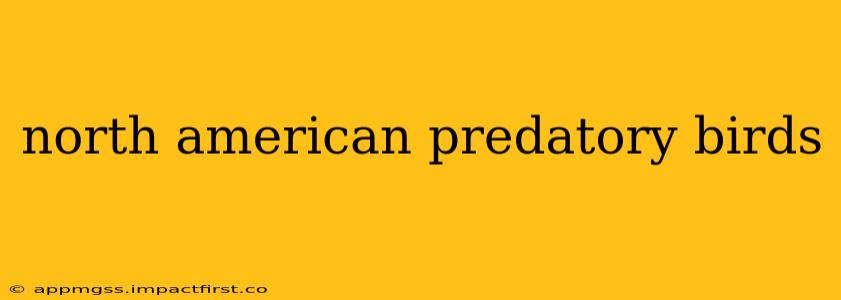North America boasts a diverse array of predatory birds, each with unique characteristics, hunting strategies, and habitats. From the majestic bald eagle to the stealthy peregrine falcon, these avian hunters play crucial roles in maintaining ecological balance. This comprehensive guide explores the fascinating world of North American predatory birds, delving into their biology, behavior, and conservation status.
What are some common North American predatory birds?
Several predatory bird species are commonly found across North America. Some of the most well-known include:
- Bald Eagle (Haliaeetus leucocephalus): The national bird of the United States, the bald eagle is a large, powerful bird of prey known for its distinctive white head and tail. They primarily feed on fish, but also scavenge carrion.
- Golden Eagle (Aquila chrysaetos): A magnificent bird of prey with a golden-brown head and neck, golden eagles are powerful hunters capable of taking down relatively large prey, including rabbits, hares, and even young deer.
- Peregrine Falcon (Falco peregrinus): The peregrine falcon is renowned as the fastest animal on Earth, reaching speeds exceeding 200 mph during its hunting dives. They primarily hunt birds in mid-air.
- Red-tailed Hawk (Buteo jamaicensis): One of the most widespread hawks in North America, the red-tailed hawk is easily identifiable by its characteristic reddish tail. They are opportunistic hunters, feeding on rodents, snakes, and other small animals.
- Osprey (Pandion haliaetus): Specializing in fish, the osprey is a large, powerful bird with exceptional diving skills. They often build nests near bodies of water.
- Great Horned Owl (Bubo virginianus): A large, powerful owl with distinctive ear tufts, the great horned owl is a formidable predator active both day and night. They hunt a variety of prey, including rabbits, rodents, and even other birds.
What is the largest predatory bird in North America?
The California Condor (Gymnogyps californianus) holds the title of the largest predatory bird in North America. While not as widespread as some other raptors, these massive birds possess an impressive wingspan.
What are some of the smallest predatory birds in North America?
While many predatory birds are large and imposing, North America also hosts some smaller species. Examples include various species of kestrels and sharp-shinned hawks, which are significantly smaller than eagles or hawks like the red-tailed hawk. Their size allows them to hunt in more confined spaces and pursue smaller prey.
What are the different types of predatory birds in North America?
North American predatory birds are broadly categorized into several families, including:
- Accipitridae (Hawks, Eagles, Kites, Harriers): This family encompasses a wide variety of diurnal (day-active) raptors, varying greatly in size and hunting techniques.
- Falconidae (Falcons): Known for their exceptional speed and aerial hunting prowess, falcons are specialized bird predators.
- Strigidae (Owls): Nocturnal (night-active) raptors, owls possess remarkable hearing and silent flight, making them highly effective hunters in low-light conditions.
- Pandionidae (Ospreys): This family contains only one species, the osprey, a highly specialized fish-eating bird.
How do predatory birds help the ecosystem?
Predatory birds play a vital role in maintaining ecological balance. By controlling populations of rodents, rabbits, and other small mammals, they prevent overgrazing and the spread of disease. They also regulate populations of other birds, helping to maintain biodiversity.
What are the threats to North American predatory birds?
Several factors threaten North American predatory birds, including:
- Habitat loss: Destruction and fragmentation of their natural habitats due to deforestation, urbanization, and agricultural expansion.
- Pesticide use: Exposure to pesticides can weaken birds, reduce reproductive success, and lead to death.
- Collisions with human structures: High-speed collisions with power lines, wind turbines, and buildings are a significant cause of mortality.
- Lead poisoning: Ingestion of lead shot from hunting ammunition can cause severe poisoning and death.
How can I help protect North American predatory birds?
You can contribute to the conservation of North American predatory birds by:
- Supporting conservation organizations: Donate to or volunteer with organizations dedicated to protecting raptors and their habitats.
- Protecting natural habitats: Support initiatives that protect and restore natural habitats.
- Using lead-free ammunition: If you hunt, switch to non-toxic ammunition.
- Educating others: Share your knowledge about the importance of predatory birds and the threats they face.
This comprehensive overview highlights the incredible diversity and ecological importance of North American predatory birds. By understanding their biology, behavior, and the challenges they face, we can work together to ensure their survival for generations to come.
